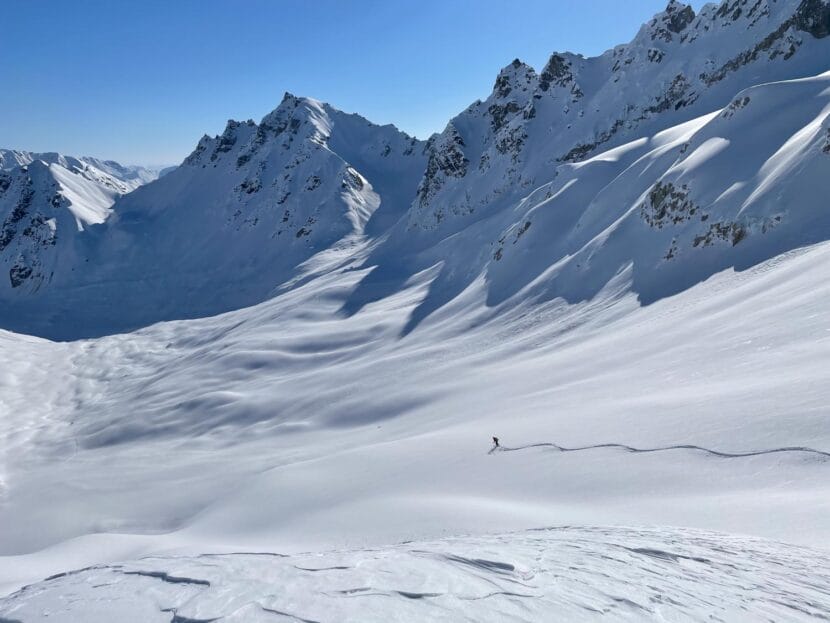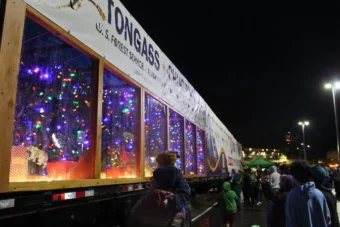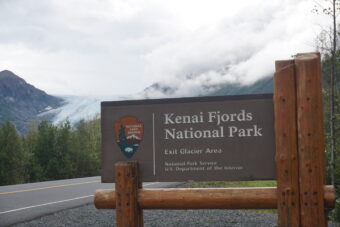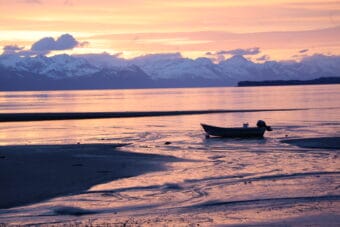
It’s that time of year when Alaska’s backcountry skiers, snowboarders and mountaineers are thinking about enjoying the snow-covered mountains. And, of course, it’s on those snowy slopes that avalanches can strike.
Well, one of Alaska’s foremost backcountry ski guides and avalanche safety educators has a new book out on the subject.
Joe Stock’s “The Avalanche Factor” follows his well-known guidebook “The Alaska Factor.”
Stock says the new book is equal parts avalanche science and avalanche risk mitigation. And he says it’s the culmination of many years of experience and education prompted by a very unfortunate incident decades ago on the other side of the globe.
Listen:
The following transcript has been lightly edited for clarity.
Joe Stock: Yeah, I’ve kind of been interested in avalanches I guess since when I first went backcountry skiing as like a little kid. But then in my early 20s, in New Zealand, I was going to college in New Zealand, and a friend and I were descending from a climb on the third day, and we were really out of food, out of water, soaking wet, tired, and it stormed that night, and he was avalanched over a cliff and killed. And they didn’t find him for eight months. But that was when I realized that, you know, my understanding, that I needed to learn a lot more about avalanches. And they’re much more complex than I actually previously thought. But, you know, this avalanche education is a lifelong thing. You always find out more stuff that you need to know. So that was like the first time I realized, “Wow, this is really complicated. And there’s a lot to learn about this.”
Casey Grove: Yeah, no doubt. And, you know, sorry about your friend. I think a lot of people that do risk mitigation or, you know, are traveling in the backcountry in different ways, have, unfortunately, similar stories. A friend that was close to them passed away, and it motivated you to learn more.
What can you tell me about the unpredictability of avalanches? I mean, I feel like there’s information, and people talk about what the danger level is for a particular day, but it’s a little bit more complicated than just like a green light, yellow light, red light kind of thing, right?
Joe Stock: Right, yeah, that’s very true. Yeah, there’s only so much you can actually know about the avalanche conditions in the snowpack. And then the key there is recognizing that there’s this inherent uncertainty and you don’t know it all. Sometimes, you know more, like when it’s frozen into a brick on a spring morning, but most of the time in the winter, there’s a lot you don’t know about the snowpack. So you add these margins of safety, just to stay away from that potential avalanche. So margins for safety, you’d be spreading out, stopping the safe zones, spotting your partner, turning around — turning around a lot, just based on like a bad feeling — starting on small terrain, and then maybe go into bigger terrain, if everything aligns. So it’s, yeah, adding these margins of safety, because you don’t really know exactly when it’s going to avalanche or not avalanche. So acknowledging that and putting those margins of safety in place to account for that uncertainty.
Casey Grove: Yeah. You’ve written about a lot of different stuff at stockalpine.com, in the posts that you do there and trip reports and things. And one that just kind of popped into my head, you were talking about kind of the difference between, you know, “Were we smart, and that’s the reason why we avoided an avalanche today? Or did we just get lucky?” And I wonder if you can tell me a little bit more about that.
Joe Stock: Yeah. Are we smart, or were we lucky? Are we really good? Are we lucky? So that’s, that’s a great question. Because a lot of these avalanche decisions you make, you can have a good outcome, but it doesn’t mean you made a good decision. You know, luck is a real thing in avalanches, and we all know that. It’s kind of like this taboo subject that we almost don’t really talk about, but luck is real. And the more you practice, and the more you learn, and the more you debrief, and the more you gain knowledge, the luckier you’re gonna get.
Casey Grove: I think I read in a note about the book release that you said it had taken four years to write this book. So why did it take you so long, Joe?
Joe Stock: Yeah, it took me four years to write this book, because it’s a complicated topic. You know, writing the guidebook, “The Alaska Factor,” took a year, because it’s relatively straightforward. It’s just like getting the stuff in my head down on paper. But the avalanche topic, there’s so much to it and trying to wade through what’s important and what’s not important, and then put this in a logical order, so you can read the book all the way straight through. Getting the thing initially written took a year, and then I took a year to revise that on my own. And then I took another two years to get edits from other people. And that was a really interesting and a great learning process to talk to so many knowledgeable people about avalanches.
Casey Grove: You know, this is not my personal opinion, but people will say, “Well, why do you even go there to begin with?” Because it’s inherently dangerous. And, you know, if you just stayed home, you would be mitigating the risk, like, almost 100%. So why even do this?
Joe Stock: Yeah, going backcountry skiing is dangerous. Well, there’s ways of reducing your danger down enough, your risk down enough, to a level that you feel comfortable with. I mean, there’s always the inherent danger out there that you’re exposed to. But, you know, going out in the backcountry and exposing yourself to these dangers is part of living a complete life and being alive. You know, if you’re not exposed to any danger, then it’s like, well, I guess, what is life? So it kind of adds so much being in the backcountry and learning how to manage those risks and reduce them and trying to make smart decisions, and it is part of living a full and complete and happy life.


